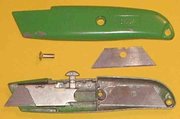Utility knife
|
|
Aaknife1.jpg
A utility knife or box cutter is a common tool used in various trades and crafts for a variety of purposes.
Such a knife generally consists of a simple and cheap holder, typically flat, approximately one inch (25 mm) wide and three to four inches (75 to 100 mm) long, and typically made of either metal or plastic. Some use standard razor blades, others specialised double-ended blades as in the illustration. The user can manually adjust how far the blade extends from the handle, so that for example the knife can be used to cut the tape sealing a package without damaging the contents of the package. When the blade becomes dull, it can be quickly reversed or switched for a new one. Spare blades are often stored in the knife handle.
This type of tool is known in British English and Australian English as a Stanley knife, after one of the first manufacturers to create this kind of implement. The genuine Stanley knife has a cast-metal body, and comes both in retractable versions and in fixed blade versions which allow no depth adjustment. Fixed blade versions are widely used for handcrafts. The blades for a Stanley knife come in both double and single ended versions, and are interchangeable with many but not all of the later copies. Specialised blades also exist for cutting string, linoleum and other purposes. Spare or used blades may be stored in the handle.
Another style is one in which a handle, usually of plastic, contains a long, segmented blade which slides out from it. As the endmost edge becomes dull, it can be snapped off from the rest of the blade, exposing the next section which is sharp and ready for use. When all the individual segments are used, it is thrown away or a replacement blade is inserted. This kind often comes in bright colors like orange, blue and yellow.
A style that is often used for the cutting of boxes consists of a simple sleeve around a rectangular handle into which ordinary razor blades can be inserted. The sleeve slides up and down on the handle, holding the blade in place during use and covering the blade when not in use.
Utility knives as weapons
Though such knives are not usually considered weapons, it was suggested by certain United States government officials that "box-cutter knives" were used in the September 11, 2001 attacks against that country. However, the exact design of these knives is unclear. See Airport security repercussions due to the September 11, 2001 attacks for further discussion.
They have also been used by minor criminals in muggings, and some schools ban their possession on school grounds; a campaign against the sale of box-cutter knives to young people was instigated in New York by Mayor Rudy Giuliani in the 1990s.
On June 1, 2004 Japanese elementary school student Satomi Mitarai was stabbed to death by a classmate using a segmented-type utility knife.
In Australia, it is illegal to sell a cutting implement such as a utility knife to anyone under 16 years of age, and proof of age is often demanded of purchasers.
Recently in the United Kingdom, there has been plans to raise the age limit of purchasing knives including utility knives from 16 to 18 as a plan to tackle "yob culture".
External links
- Product catalog (http://www.olfa.com/products.asp?C=2) showing lots of pictures of Olfa segmented blade cutters
- History of the Stanley Works (http://www.stanleyworks.com/a_history.asp)
- Another history of the Stanley Works (http://stanleytools.com/default.asp?TYPE=STATICLEFT&PAGE=history.htm&LEFT=left_history.htm)de:Cutter (Messer)

